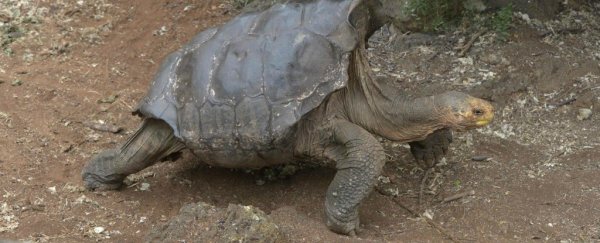An Espanola giant tortoise (Chelonoidis hoodensis) by the name of Diego has recently been credited with almost single-handedly saving his entire species from the brink of extinction by fathering over 800 offspring over the course of his lifetime.
Diego's 'work' to save his species started back in the 1960s, when there were only 14 wild tortoises - 2 male and 12 female - left on Espanola, the southernmost island in the Galapagos Archipelago and the only native habitat for the species.
Now, with roughly 2,000 captive-bred tortoises released into the wild, the species has rebounded, and it looks like Diego and his mates were largely responsible. Based on recent genetic studies, Diego has fathered roughly 40 percent of all those released.
"He's a very sexually active male reproducer. He's contributed enormously to repopulating the island," tortoise preservation specialist, Washington Tapia, from the Galapagos National Park, told the AFP.
"We did a genetic study and we discovered that he was the father of nearly 40 percent of the offspring released into the wild on Espanola."
Diego weighs 80 kilograms (175 pounds), and stretches 90 centimetres (35 inches) long and 1.5 metres (5 feet) tall - when he really stretches - and is estimated to be well over 100 years old.
He lives at a facility on Santa Cruz Island in the Galapagos, where he shares an enclosure with six females who together are tasked with repopulating Espanola.
Despite knowing all about Diego's sex life, the researchers who work with him don't know much else about him. But what they do know is that he was discovered at the San Diego Zoo in the late-1950s, and was probably taken from the Espanola at some stage before that, though there's no way to know for sure.
"We don't know exactly how or when he arrived in the United States. He must have been taken from Espanola sometime between 1900 and 1959 by a scientific expedition," Tapia told the AFP.
After years of captive breeding, Diego has fathered upwards of 800 offspring that have been reintroduced to the wild, putting his species back on the map, though work is still needed to ensure the population will continue to thrive.
"I wouldn't say [the species] is in perfect health, because historical records show there probably used to be more than 5,000 tortoises on the island," Tapia said. "But it's a population that's in pretty good shape - and growing, which is the most important."
While Diego represents a success story, not all Galapagos tortoise species have been so lucky.
The AFP reports that there are 15 known species in the archipelago, and two have already vanished, including Chelonoidis abingdoni, which went extinct in 2012 after its last surviving member - a tortoise named Lonesome George - refused to mate in captivity during his 100-year-long lifespan.
Hopefully, as researchers continue to try and rebuild these populations - which were largely decimated by pirates in the 18th century - the islands in the Galapagos will return to their former glory.
Until then, rest easy knowing that at least one species - spearheaded by the insatiable sex drive of a single tortoise named Diego - is starting to do better.
